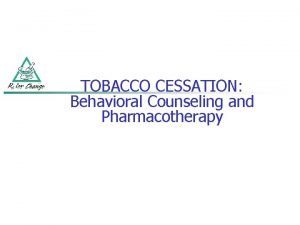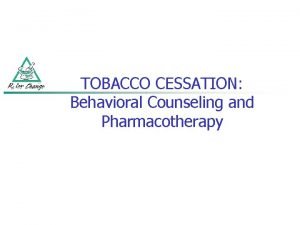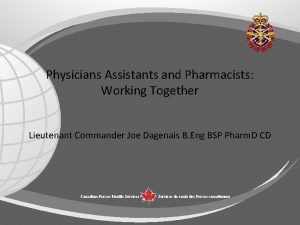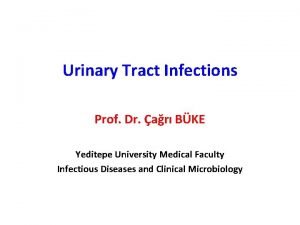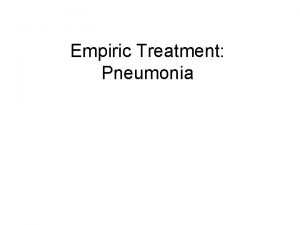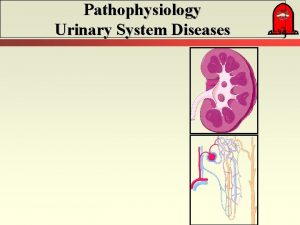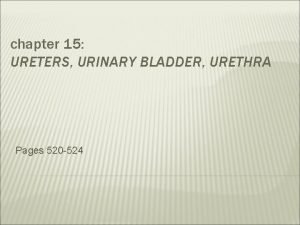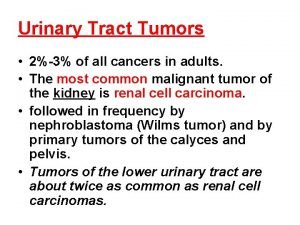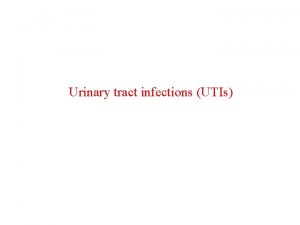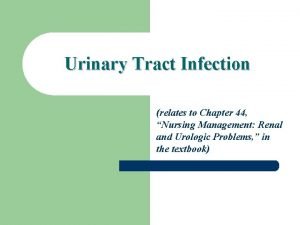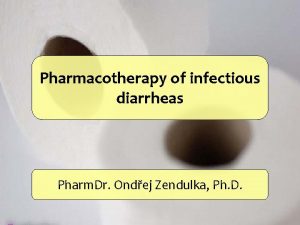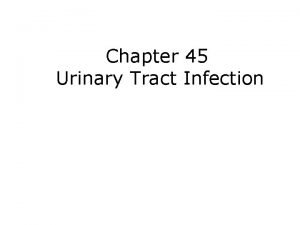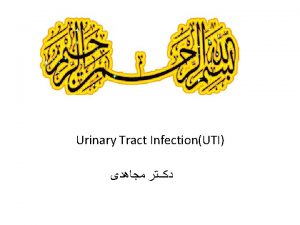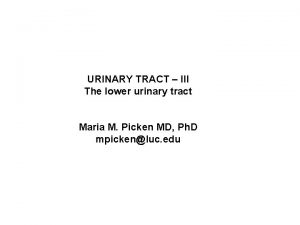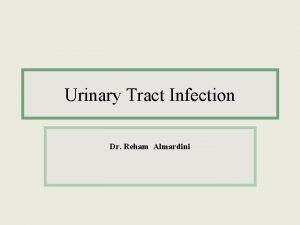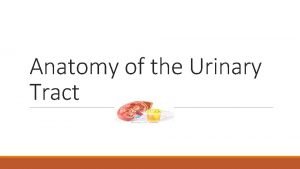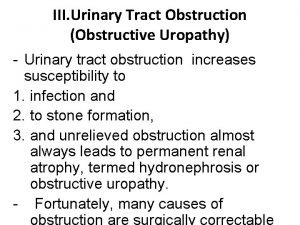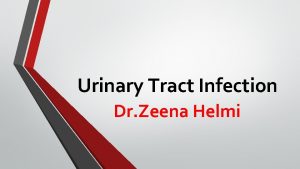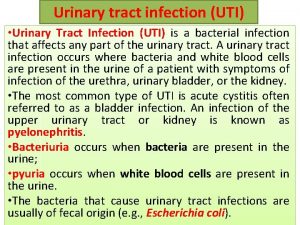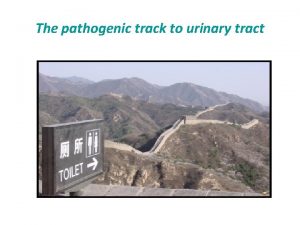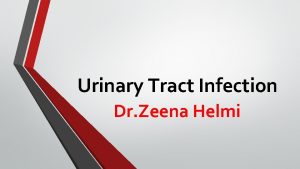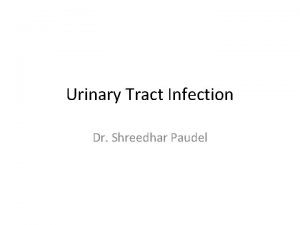PHARMACOTHERAPY OF URINARY TRACT INFECTIONS AND INFECTIOUS DIARRHEAS














- Slides: 14

PHARMACOTHERAPY OF URINARY TRACT INFECTIONS AND INFECTIOUS DIARRHEAS Pharm. Dr. Ondřej Zendulka, Ph. D. MUDr. Alena Máchalová, Ph. D. Mgr. Jana Merhautová Notes for Pharmacology II Practicals This study material is exclusively for students of general medicine and stomatology in Pharmacology II course. It contains only basic notes of discussed topics, which should be completed with more details and actual information during practical courses to make a complete material for test or exam studies. Which means that without your own notes from the lesson this presentation IS NOT SUFFICIENT for proper preparation for neither tests in practicals nor the final exam.

Pharmacotherapy of UTI Antibiotics – acute infection: Drugs of 1 st choice: ‒ nitrofurantoin ‒ co-trimoxazole ‒ cephalosporins of 1 st a 2 nd generation – e. g. cefuroximeaxetil ‒ amoxicillin, co-amoxicillin Drugs of 2 nd choice: ‒ fluoroquinolones – ofloxacin, ciprofloxacin, prulifloxacin ‒ trimethoprim ‒ cephalosporins of 3 rd generation

Pharmacotherapy of UTI Secondary prevention treatment – chronic recurrent infections: • long-lasting administration of low doses of ATB ‒ nitrofurantoin, fluoroquinolones • immunotherapy ‒ bacterial lysate of E. coli (activates T lymphocytes, ↑ Ig. A) ‒ autovaccines – p. o. , inj. dosage forms Adjuvant therapy: • Species urologicae (urological herbal mixture) • Artostaphylos uva-ursi (bearberry) • Tropaeolum majus (garden nasturtium, Indian cress) • cranberries, D-mannose • acidification of urine (ascorbic acid) – only if there is no contraindication

Renal Infections Non-complicated pyelonephritis: • used ATB: ‒ co-amoxicillin ‒ cephalosporins of 2 nd generation – cefuroxime-axetil, cefprozil ‒ fluoroquinolones – ciprofloxacin, ofloxacin ‒ co-trimoxazol • complicated pyelonephritis – ATB according to cultivation and local resistance, ATB as above + e. g. aminoglycosides


Therapy of Diarrheas • Rehydration – water, mineral water (non-carbonated), tea, oral rehydration therapy – solutions: ‒ WHO rehydration solution: H 2 O 1. 0 L, Na. Cl 3. 5 g, Na. HCO 3 2. 5 g, KCl 1. 5 g, glucose 20. 0 g ‒ Valík‘s rehydration solution – for children: H 2 O 1. 0 L, Na. Cl 2. 4 g, Na. HCO 3 1. 7 g, KCl 1. 1 g, glucose 27. 0 g ‒ home-made rehydration solution: 1 L of boiled water (tepid), 8 teaspoons of sucrose (glucose, fructose), 1 teaspoon of salt, juice from 2 oranges: adults 250 – 500 m. L/h, children 125 – 250 m. L/h • Diet, realimentation

Therapy of Diarrheas • Eubiotics ‒ prebiotics – oligo- and polysaccharides, B-vitamins ‒ probiotics – living microorganisms (Lactobacillus, Bifidobacterium, some G+ cocci and Saccharomycetes) ‒ RMP: ‒ preparation with defined content of Sacharomyces boulardii siccatus, Lactobacillus sp. ‒ concentrate of metabolic products of E. coli, Streptococcus faecalis, Lactobacillis acidophillus, L. helveticus • non-specific treatment of ID – adsorbents, antiseptics etc. • specific treatment – ATB

Diarrheas Caused by ATB • ATB with broad spectrum • prevention: eubiotics • pseudomembranous colitis ‒ Clostridium difficile ‒ ileus, toxic megacolon, sepsis ‒ therapy: metronidazole, vancomycin ‒ most frequent after the administration of lincosamides, aminopenicillins, cephalosporines, fluoroquinolones

Intestinal Adsorbents • adsorption of undesirable substances from GIT to active surface of an adsorbent • potential interaction with co-administered drugs • activated charcoal (Carbo medicinalis, C. activatus) • diosmectite (aluminium-magnesium silicate) Adstringents • denaturation of intestinal wall proteins, formation of hydrophobic layer, which↓ secretion into the intestine • black tea, herbal mixtures (medical plants rich in tannins) • diosmectite, bismuth subsalicylate, bismuth subgallate

Antimotility Agents • intestinal opioid receptors agonists • ↓ peristaltic propulsion, ↑ smooth muscle tone, ↑ resorption of water and electrolytes • slow down passage of GIT content • contraindication: infections with invasive pathogens, poisoning • diphenoxylate – Rx. • loperamide – OTC

Intestinal Antiseptics • minimal or no absorption from GIT • traveler‘s diarrheas chloroxine nifuroxazide rifaximin

ATB in the Treatment of Diarrheas We use ATB only in the case of: • severe and complicated infectious diarrheas, or positive blood cultures • immunodeficiency of the patient • traveler‘s diarrheas • typhus and paratyphoid fever • pseudomembranous colitis Salmonella – cotrimoxazole, quinolones, amoxicillin Campylobacter – macrolides, quinolones (resistance) Shigella – amoxicillin, quinolones, cotrimoxazole traveler‘s diarrhea – metronidazole, intestinal antiseptics parasitic diarrhea – mebendazol, albendazol (antiparasitics)

Antispasmodics (Spasmolytics) of GIT • neurotropic antispasmodics – act via VNS • musculotropic antispasmodics – directly influence myocytes Neurotropic Antispasmodics • PARASYMPATOLYTICS • atropine • substances with N+ ‒ otilonium, trospium, fenpiverinium…

Musculotropic Antispasmodics • various mechanisms of action, mainly blockade of L-type Ca 2+ channels, activation of K+ channels, interference with muscle contraction biochemistry • papaverine • drotaverine, alverine, mebeverine, pitofenone • combinations of neurotropic, and musculotropic antispasmodics, and analgesics • spasms of GIT, bile duct, or gall bladder, UT spasms, irritable bowel syndrome, spasmodic dysmenorrhea, migraine… • spasmo-analgesia
 Pharmacotherapy
Pharmacotherapy Pharmacotherapy
Pharmacotherapy Pharmacotherapy workup
Pharmacotherapy workup Sterile pyuria ppt
Sterile pyuria ppt Complicated urinary tract infection
Complicated urinary tract infection Urinary tract obstruction
Urinary tract obstruction Urethra
Urethra Tumor in the urinary tract
Tumor in the urinary tract Urinary tract infection in pregnancy ppt
Urinary tract infection in pregnancy ppt Urised otc
Urised otc Urinary system histology
Urinary system histology Pyramidal vs extrapyramidal lesions
Pyramidal vs extrapyramidal lesions Olivospinal tract vs tectospinal tract
Olivospinal tract vs tectospinal tract Chapter 25 sexually transmitted infections and hiv/aids
Chapter 25 sexually transmitted infections and hiv/aids Understanding the mirai botnet
Understanding the mirai botnet
